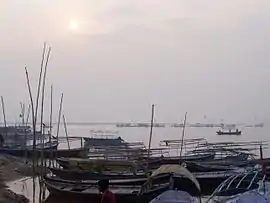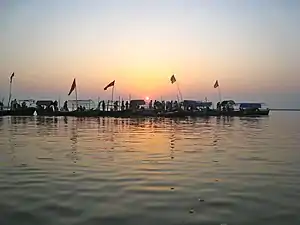Triveni Sangam
In Hindu tradition, Triveni Sangam is the confluence (Sanskrit: sangama) of three rivers that is also a sacred place, with a bath here said to flush away all of one's sins and free one from the cycle of rebirth[1][2][3][4]

Triveni Sangam in Prayag

Triveni Sangam in Prayag is the confluence of Ganga (Ganges), Yamuna, and the mythical Saraswati River located in Allahabad (Prayagraj). Ganga and Yamuna can be identified by their different colours – the water of Ganga is clear while that of Yamuna is greenish in colour.[5] The third river, mythnical Saraswati, is called invisible.
A place of religious importance and the site for historic Kumbh Mela held every 12 years, over the years it has also been the site of immersion of ashes of several national leaders, including Mahatma Gandhi in 1948.[6]
The auspiciousness of the confluence of two rivers is referred to in the Rigveda, which says,"Those who bathe at the place where the two rivers flow together, rise up to heaven"[7]
Triveni Sangam in Kooduthurai
The Triveni Sangam in Kooduthurai, Erode is a confluence of the Kaveri, Bhavani and Amudha and is known as the South Indian Triveni Sangam, or Dakshina Sangam. Of these three, the river Amudha is invisible and is said to flow underground and join the other two rivers from below. It is also called as Kooduthurai, where the famous Sangameswarar Temple is located.
Other Triveni Sangams
Bhagamandala
Bhagamandala is a pilgrimage place in Kodagu district of Karnataka. It is situated on the river Kaveri in its upstream stretches. At this place, the Kaveri is joined by two tributaries, the Kannike and the Sujyoti river. It is considered sacred as a river confluence (kudala or triveni sangama, in Kannada and Sanskrit respectively).
Tirumakudalu Narasipura
Tirumakudalu Narasipura, commonly known as T. Narasipura,[8] is a panchayat town in Mysore district in the Indian state of Karnataka. The first name refers to the land at the confluence (trimakuta in Sanskrit) at the confluence of the Kaveri, Kabini and Spatika Sarovara (a lake or spring, also named Gupta Gamini). This is the place in South India where local Kumbhamela is held every three years.[9]
Moovattupuzha
Kaliyar (Kali river), Thodupuzhayar (Thodupuzha river) and Kothayar (Kothamangalam river) merge and become Muvattupuzha river in Kerala and hence this place is called Muvattupuzha.
Munnar
Munnar city is where Mudhirapuzha, Nallathanni and Kundaly rivers merge, the name Munnar literally means "three rivers" in Malayalam and Tamil.
Kandakurthi
Kandakurthi is a village in Renjal mandal of Nizamabad district in the Indian state of Telangana. The river Godavari merges with the rivers Manjira and Haridra.
References
- Mohan, Vineeth (19 September 2016). "Places Connected To Lord Rama And Ramayana - Prayag". https://www.nativeplanet.com. Retrieved 20 January 2021. External link in
|website=(help) - "Ganges". Ancient History Encyclopedia. Retrieved 20 January 2021.
- "Ganges River – India". Sacred Land. Retrieved 20 January 2021.
- "Ganges' Most Sacred Stretch Rich with Tradition". NPR.org. Retrieved 20 January 2021.
- "Triveni Sangam". Retrieved 3 December 2015.
- At the Three Rivers TIME, 23 February 1948.
- Eck, Diana L. (26 March 2013). India: A Sacred Geography. ISBN 9780385531924.
- Gram Panchayat and Taluk Boundary Map
- Kumar, R. Krishna (2013). "The Hindu : States / Karnataka : Preparations on for regional version of Kumbh mela". thehindu.com. Retrieved 15 January 2013.
The T. Narsipur Kumbh Mela, being held from February 23 to 25, began around 20 years ago and is held once in three years.